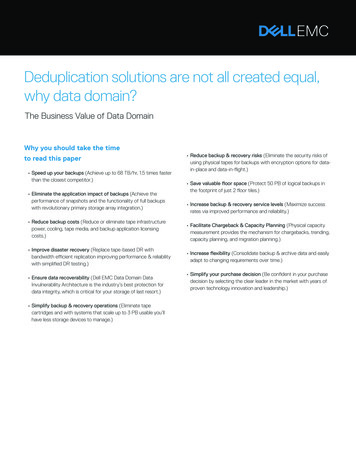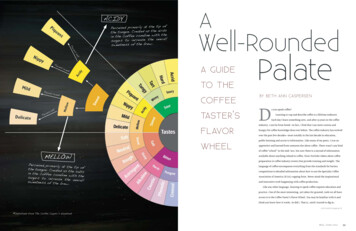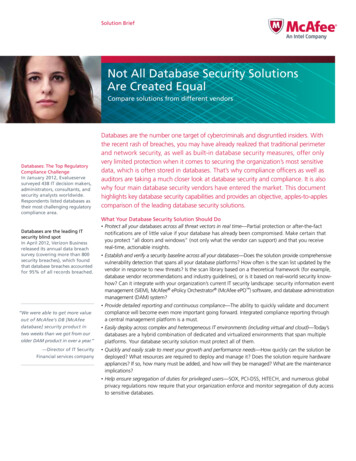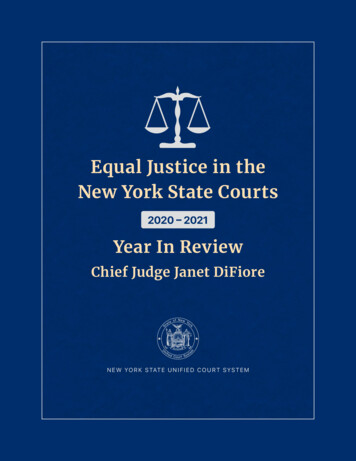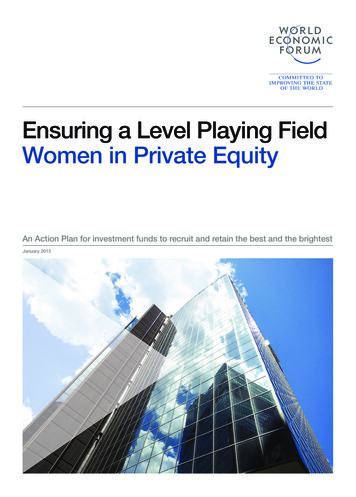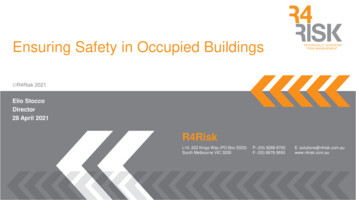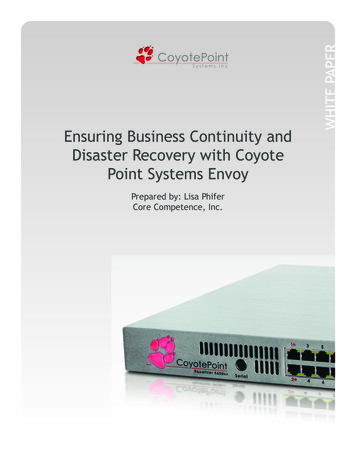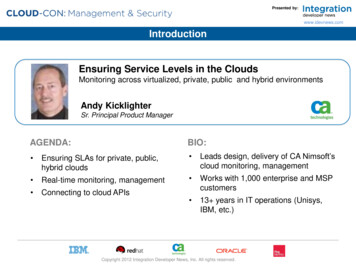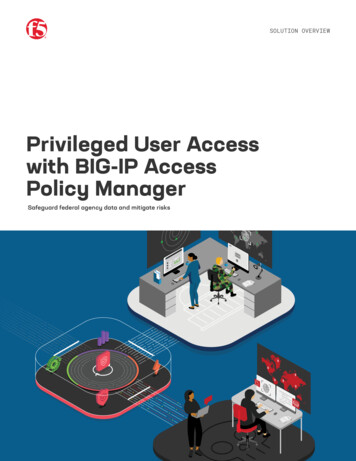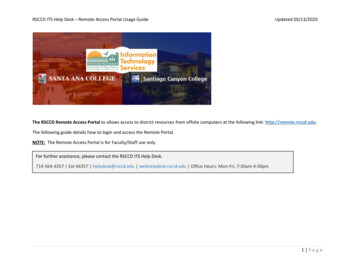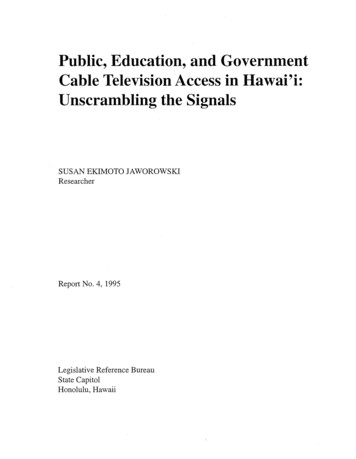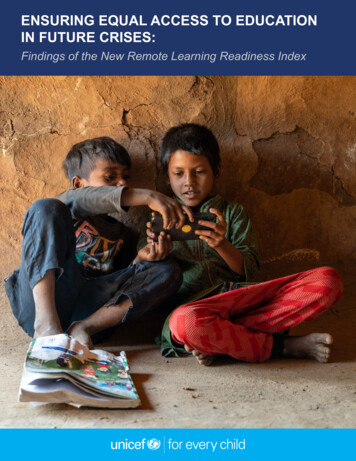
Transcription
ENSURING EQUAL ACCESS TO EDUCATIONIN FUTURE CRISES:Findings of the New Remote Learning Readiness IndexEnsuring Equal Access to Education in Future Crises:Findings of the New Remote Learning Readiness Index1
AcknowledgementsThe report was produced by Suguru Mizunoya, Garen Avanesian, Enrique Delamónica,Sakshi Mishra, and Yixin Wang from the UNICEF Data and Analytics Section, ThomasDreesen from UNICEF Office of Research, and Haogen Yao from UNICEF ProgrammeGroup.Valuable comments and inputs were provided by the UNICEF Data, Analytics, Planning andMonitoring (Vidhya Ganesh, Margaret Kelly, Karoline Hassfurter, Anshana Ranck, ThierrySchlaudecker), the UNICEF Office of Research (Matt Brossard, Akito Kamei, AninditaNugroho), the UNICEF Education Programme Group (Nicolas Reuge, Jean Luc Yameogo,Rachel Cooper, Neven Knezevic, Linda Jones, Juan Pablo Giraldo Ospino, Bassem Nasir),the UNICEF Division of Global Communication and Advocacy (Sara AlHattab, Ann MarieWilcock), and João Pedro Azevedo from the World Bank.The team would also like to thank Anna Giovinetto for editing the report, and Yug Kapoorfor its design.This work was supported by the Global Partnership for Education Knowledge andInnovation Exchange, a joint endeavour with the International Development ResearchCentre, Canada.Suggested citationUnited Nations Children’s Fund, “Ensuring Equal Access To EducationIn Future Crises: Findings of the New Remote Learning Readiness Index“ UNICEF, NewYork, 2021.Photo AcknowledgementsPhoto creditsCover page: ️ UNICEF/UN0378283/PanjwaniPage 4: ️ UNICEF/UN0473532/MulalaPage 5: ️ UNICEF/UN0500187/MarquesPage 6: ️ UNICEF/UNI313416/McIlwainePage 10: ️ UNICEF/UN0360190/ChoufanyPage 11: ️ UNICEF/ UN0452190/ BeguelPage 14: ️ UNICEF/UNI354545/AndradePage 16: ️ UNICEF/UN0393292/SatuPage 18: ️ UNICEF/UNI322054/SuleimanPage 23: ️ UNICEF/UN0360192/ChoufanyPage 24: ️ UNICEF/UNI325600/DejonghPage 27: ️ UNICEF/UNI322355/SchverdfingerEnsuring Equal Access to Education in Future Crises:Findings of the New Remote Learning Readiness Index2
ContentsAbout the Index4Key Messages5Introduction6Methodology8Global and Regional Overview11Remote learning readiness for pre-primary education16Readiness for remote learning and environmental risks18Economic development and readiness for remote learning20Remote learning readiness and duration of school closures21One-star countries: Where is improvement most urgentlyneeded?22Five-star countries: Achieving a high RLRI score is merely astarting point to ensure learning24Conclusions27Annex: Remote Learning Readiness Index by level of education28Ensuring Equal Access to Education in Future Crises:Findings of the New Remote Learning Readiness Index3
About the index1.The Remote Learning Readiness Index (RLRI) is a newcomposite indicator to measure countries’ readiness todeliver remote learning in response to school closuresor the disruption of in-person learning. The index iscomposed of three domains: households, a government’spolicy response capacity, and the emergencypreparedness of the national education sector.3.The index ranks countries’ performance, with countries atthe top receiving five stars and those at the bottom onestar. Results are presented for (a) the overall educationsystem from pre-primary to upper secondary, and (b) bylevel of education. For each level of education, the resultcan be decomposed by domain to identify the key areas inwhich the overall score could be improved.2.The household domain evaluates the householdenvironment for remote learning using access totechnology and mother’s education level as proxies. Thepolicy response domain uses the governmental responseto COVID-19 as a proxy for the agility and adaptivityof policy during times of crisis. The system-level-levelemergency preparedness domain utilizes UNICEF’sStrategic Monitoring Questions to assess whether theeducation sector has the capacity and adequate resourcesto ensure that the education system can continuefunctioning during times of crisis.4.The index reinforces the importance of investment intoremote/digital tools to deliver education, which howevershould not be done at the expense of in-person learning.Whilst resilience of education systems to pivot in the faceof extreme situations is crucial, the ability to go to schoolremains paramount for children’s overall development andwellbeing.Ensuring Equal Access to Education in Future Crises:Findings of the New Remote Learning Readiness Index4
Key messages1.Among the 67 countries analyzed, 19 have above-averageremote learning readiness (i.e., four or five stars), 17have average remote learning readiness (i.e., three stars)and 31 countries have below-average remote learningreadiness (i.e., one or two stars).2.More than 200 million students reside in the 31 countrieswith a rank of one or two stars, and 102 million of thesestudents come from 14 countries where at least 50 percent of in-person learning time was lost to full or partialschool closures in the last 18 months.3.Children in countries with long school closures andlow remote learning readiness, such as Angola, Congo,Madagascar, and Pakistan, were most affected, as theymissed out on in-person instruction due to a lack ofconditions necessary to support remote learning.4.Among all education levels, the pre-primary level has thehighest number of countries with below-average remotelearning readiness. Many countries didn’t have policiesaddressing remote learning for this level, putting many ofthe youngest children at risk of not learning during schoolclosures.5.In 23 of the 31 countries that scored one or two stars inthe RLRI, children have high or extremely high exposureto climate and environmental hazards. This means that196 million schoolchildren in these countries face risks oflearning disruption that go beyond the current pandemic.These data emphasize the need to build resilienteducation systems that can equitably ensure learningcontinuity through remote channels at times whenenvironmental factors substantially affect the ability todeliver in-person education.6.Overall, countries with per capita gross national income(GNI) higher than US 10,000 tend to have average orabove-average remote learning readiness. However,many countries with relatively low GNI managed tohave an above-average score, opening the possibilityfor international cooperation and the exchange of bestpractices.7.Because the RLRI is measured at the national level,it is also critical to consider within-country disparities,especially due to inequalities among households. Even incountries with the highest readiness for remote learning(Argentina, Barbados, Jamaica, and the Philippines),children from the poorest households do not have accessto assets necessary for remote learning, so they facehigher risks of falling further behind in their education.Furthermore, available evidence at the country levelsuggests that even in the top-scoring countries, parentsreported their children to learn less under the remotelearning modalities.8.It is important to understand that having adequate remotelearning readiness is only the first step in ensuringlearning continues during schooling disruptions. Ongoingefforts should be made to design effective remote learningcurricula for all children and promote their actual use.Ensuring Equal Access to Education in Future Crises:Findings of the New Remote Learning Readiness Index5
IntroductionThe COVID-19 pandemic has impacted national educationsystems worldwide. The number of students affected byschool closures peaked in April 2020 at more than 1.5 billionchildren around the world, representing about 90 per cent oftotal enrolled learners in 194 countries.To mitigate the effects of school closures, governmentsstarted introducing remote learning policies based on acombination of broadcast media, online platforms, andpaper-based material delivery. However, decisions regardingremote learning solutions were influenced by a country’sincome, especially when it came to “differences in adoptionof online learning platforms,” which highlights that “low- andmiddle-income countries are at a far more disadvantagedstarting point for an effective transition to online learningplatforms” (Global Education Monitoring Report: Inclusion andEducation, p.58-59, 2020).Moreover, existing evidence indicates that the disparitiesobserved in access to the internet and informationcommunication technologies (ICTs) at home due to thedifferences in socio-economic standing could widen alreadyEnsuring Equal Access to Education in Future Crises:Findings of the New Remote Learning Readiness Index6
severe learning inequities. Therefore, a significant share ofschoolchildren worldwide could be left behind despite theexistence of remote learning policies (Hereward et al., 2020;Dreesen et al., 2020). Available data highlight that about 30per cent of schoolchildren worldwide cannot continue learningthrough remote channels, and approximately three out of fourin this disadvantaged population come from rural areas and/orbelong to the poorest strata in their countries (UNICEF, 2020).Additional data suggest that for countries in fragile contexts,namely those included in the UNICEF Humanitarian Action forChildren (HAC) appeal, this number increases to almost 50per cent, which highlights an urgent need to support learningcontinuity in humanitarian crisis settings. Furthermore, duringthe pandemic some children in low-income settings haveremained without access to electricity, which cuts them off notonly from learning opportunities but also from access to basicand essential services beyond education. For example, only 47per cent of households in sub-Saharan Africa have access toelectricity, with large disparities observed between rural andurban areas (UNICEF, 2021).Since the COVID-19 pandemic was announced in March 2020,countries have responded differently to ensure continuity oflearning through remote channels. As school closures are notunique to the COVID-19 outbreak and can take place due tonatural or man-made disasters, conflicts, etc., strengtheningthe resilience of the education sector against negative shocksand learning loss is essential for human capital gains andinclusive and equitable education for all (UNICEF, 2021).A country-level assessment of educational resilience inrelation to crises is essential to accelerate the efforts of theinternational community and national stakeholders in “buildingback better,” i.e., recovering from the learning losses causedby the disruption of in-person classroom during the COVID-19pandemic.One calendar year since the pandemic was announced,almost 215 million schoolchildren worldwide missed at leastthree quarters of the intended in-person instruction time,and 168 million missed almost an entire year, which has clearconsequences in terms of severe learning loss (UNICEF, 2021).Investments in the remote learning readiness of educationsystems can play an important role in reaching out-of-schoolpopulations, refugees, or providing education for schoolchildrenin remote rural areas, and in addition to ensuring childrencontinue learning during the school closures they can alsohelp children get back on track when schools reopen. Remotelearning readiness also plays a key role in a joint missionlaunched by UNESCO, UNICEF, and the World Bank “Mission:Recovering Education – 2021,” which aims to enable allschoolchildren to return back to school by the end of 2021 andprovide all schoolchildren with the support to catch up on lostlearning.The purpose of this report is to introduce the Remote LearningReadiness Index (RLRI), a new composite indicator that aimsto identify the weakest links in a country’s readiness forremote learning, thereby supporting targeted policymaking toimprove equitable access to education. The index considersthree domains that are important for enabling remote learning:household-level access to remote learning tools, country-levelpolicy responses to COVID-19, and the preparedness of theeducation system to withstand disasters or other crises. Theindex is calculated at the national level, with disaggregationby education level, as well as by the three key domainsmentioned above.It is proposed that the RLRI could provide guidance forministries of education or other relevant policy-making bodiesin identifying critical areas and domains where additionalattention and efforts need to be made to mitigate thenegative consequences of the pandemic on learning, increaseresilience, and improve preparedness for potential schoolclosures in the future.It is important to note that readiness for remote learning is acontinuum. This index aims to capture the most foundationalrequirements of remote learning readiness and looks at thecritical infrastructure and resources needed to achieve qualityremote learning. As Figure 1 below shows, the RLRI providesinsight into where countries stand with respect to the very firststeps needed to ensure every child can learn when in-personschooling is interrupted.Figure 1What the Remote Learning Readiness Index measuresRemote learningecosystems are availablefor all studentsRemote learningecosystems are being usedby all studentsRemote learningsystems are effectivelydelivering educationEvery childis able tolearn remotelyRemote LearningReadiness IndexEnsuring Equal Access to Education in Future Crises:Findings of the New Remote Learning Readiness Index7
MethodologyThe RLRI reports a country’s remote learning readiness usinga scale of one to five stars, where higher values indicatebetter readiness. Each level of education from pre-primary toupper secondary school is assessed; in addition, the overallremote learning readiness of a country is calculated based onits performance across the three domains identified above1,which indicate key aspects of resilience and capacity inensuring the continuity of learning through remote channels.These domains are household-level access factors, the policyresponse capacity of the government, and education systemlevel preparedness for emergencies.This analysis uses three data sources to construct the index.Household survey data, including Multiple Indicator ClusterSurveys (MICS) and Demographic and Health Surveys (DHS),are used to calculate household level characteristics for remotelearning. The first round of the UNESCO-UNICEF-World BankSurvey on National Education Responses to COVID-19 SchoolClosures is used as the source for national policy responses(in subsequent years, UNICEF will conduct an annual survey tocollect data). Finally, UNICEF’s Strategic Monitoring Questions(SMQ), a system-strengthening framework that is reported byUNICEF’s country offices, form the data source for emergencypreparedness.The household level factors domain seeks to identifyavailability in the home of key technological assets needed toaccess remote learning, such as a radio, television, computer,mobile phones, and access to the internet, as well as theextent of support available at the household level. A mother’slevel of education (completed upper secondary education orhigher) serves as a proxy for potential parental support, asexisting evidence points to a strong relationship between amother’s education and schooling outcomes2.Policy response capacity is measured by the number ofpolicies adopted by a country to deploy remote learningand support teachers during the COVID-19 pandemic. Whilewidespread full school closures are becoming rare 18 monthsafter the pandemic was announced, country responses tocrises like COVID-19 can be used as a proxy to estimate how acountry will react to closures due to natural calamities or otherunexpected events. This domain helps shed light on the abilityof governments to respond to schooling interruptions and todeploy remote learning in the short and medium term.Finally, emergency preparedness of the education systemassesses the degree to which a country’s education sectorimplements risk assessment, has risk reduction strategies inplace, and allocates human and financial resources for theseactivities. This domain focuses on the overall resilience ofthe education sector in relation to emergencies. In general,governments can improve education sector resilience over themedium to long term. Figure 2 illustrates the three sourcesand 13 variables used in the index.Figure 2RLRI domains and variablesPolicy ResponseCapacityHouseholdsThe share of schoolchildren with homeaccess to:RadioVariablesTelevisionA computerThe internetAt least one mobile phone owned by afamily memberSourceAs well asThe share of school children whosemothers completed upper secondaryeducation or higherMultiple Indicator Cluster Surveys2010-2020), Demographic andHealth Surveys (2010-2020)System-LevelEmergency PreparednessProvision, through ministry of educationpolicies, of remote learning opportunitiesvia:RadioTelevisionOnline PlatformsAs well asTraining for teachers to use remotelearning toolsThe first round of the UNESCO-UNICEFWB survey (to be replaced by ad hocannual surveys from 2022 onward)Risk assessment for education sectoris implemented.Risk reduction for education sector isin place.Human and financial resources forimplementing risk reduction andassessment strategies are allocatedUNICEF Strategic Monitoring Questions(2020)1. Note that the aggregate score for a country was only calculated if all three domains were present.2. Zhao, M. & Glewwe, P. (2010). What determines basic school attainment in developing countries? Evidence from rural China, Economics of Education Review, Volume 29, Issue 3, pages 451-460.Ensuring Equal Access to Education in Future Crises:Findings of the New Remote Learning Readiness Index8
The data analysis flow included two stages of ranking. Thefirst refers to the domain-level analysis and was comprised oftwo steps. First, based on the input variables, an aggregatevalue for each domain was calculated. As three domainshave different underlying statistical distributions of the inputvariables, different ways to aggregate input variables wereadopted. Arithmetic mean was used for the householdcharacteristics as they all vary on a continuous scale from 0 to100. Policy response capacity was aggregated by counting thenumber of policies deployed by governments to enable remotelearning in response to school closures, with scores varyingfrom 0 (no policy) to 4 (maximum number of policies). Finally,education system emergency preparedness was aggregatedby taking the median value of ordinal ranks in the intervalbetween 1-4. In the next step of the first-stage ranking, eachaggregated domain was evaluated against four theoreticalbenchmarks, such as “low,” “medium-low,” “medium-high,”and “high.” These benchmarks were produced in a way thatdivides the distribution of each aggregated score into four binsof relatively equal size.The second-stage ranking started with identification of thetwo weakest domains in a country’s performance. These twodomains then were chosen to produce the final index, whichranges between one and five stars, with five being the best.Table 1 presents how the 16 possible combinations of thetwo weakest domains were classified into the final score. Tofacilitate understanding of the index, each level is color-codedas shown in the table.Table 1Conversion of the two weakest domains into the final rankLowest Domain2nd Lowest DomainHighMedium-HighMedium-LowLowHigh5 Stars5 Stars4 Stars3 StarsMedium-High5 Stars4 Stars3 Stars2 StarsMedium-Low4 Stars3 Stars2 Stars1 StarsLow3 Stars2 Stars1 Stars1 StarsIt is important to note the innovativeness of the adoptedapproach, which assesses sector-level remote learningreadiness in each country by focusing on the two domainswith the lowest ratings, rather than averaging across all threedomains. The role of household factors, policy responsecapacity, and sector preparedness in building resilient remotelearning systems is complementary, so the design of the indexreflect this nature of complementarity. In the same way thatthe overall strength of a chain is determined by the weakestlink, the domains with the weakest scores are the constrainingfactors in ensuring a country’s readiness for remote learning.For example, a well-designed remote learning policy cannotachieve its full impact if many learners do not have access toremote learning tools at home. In this context, focusing on thesingle weakest domain could result in a loss of informationon how resilient the country is toward school closures. Onthe other hand, focusing on all three domains produces 64outcome cases, which complicates production of the finalscore in a simplistic manner. Furthermore, taking informationfrom the best domain does not contribute to identification ofthe weakest links. The complementary nature of three domainsplaces the focus on the weaker parts of the system. Whenthe overall ranking is based on the two weakest domains,the results are more sensitive to capturing a country’simprovement over time. The index can identify a country’sweakest areas in providing access to remote learning, andthereby support the implementation and monitoring ofappropriate policy.Ensuring Equal Access to Education in Future Crises:Findings of the New Remote Learning Readiness Index9
BOX 1How to interpret the star rankingsThe RLRI evaluates each country’s performance across three domains, and then assigns a star ranking based on thecountry’s performance in the two domains in which it is weakest:1 STAR:A country receives one star if it demonstrates poorperformance in its two weakest domains. A one-starrating highlights the urgent need for a country toinvest in developing a remote learning system, as thecurrent system is only available to a limited number ofschoolchildren, making learning continuity during schoolclosures very difficult.2 STARS:A country receives two stars if it demonstrates lowestor medium-low performance in its two weakestdomains. A two-star rating highlights that while somestudents can benefit from remote learning, it remainsunavailable for the majority of students in the countrydue to a combination of factors.3 STARS:A country receives three stars if it demonstratesaverage performance in its two weakest domains. Athree-star rating signifies that the country’s remotelearning systems can be regarded as relatively resilient,although serious concerns still remain about thepotential for learning loss and the extent to whichlearning can continue in case of disrupted in-personinstruction.4 STARS:A country receives four stars if it demonstratesmedium-high performance in its two weakestdomains. A four-star rating identifies countries withwell-established and resilient systems of remotelearning, where most students can continue to learnif schools are closed, although there are areas whereimprovement is still needed.5 STARS:A country receives five stars if it demonstrates highperformance across all domains. A five-star ratingidentifies countries with the best readiness for remotelearning and the highest resilience to crises that leadto disruption of in-person instruction, although otherfactors beyond the assessment (such as actual learningor within-country inequalities) should guide furtherpolicy discussions to strengthen the overall ecosystemof remote learning in the country.Ensuring Equal Access to Education in Future Crises:Findings of the New Remote Learning Readiness Index10
Global and regional overviewAcross different education levels, it is evident that the higherthe level of education, the more countries achieve aboveaverage remote learning readiness. This trend in remotelearning readiness reveals that pre-primary education is oftenexcluded from remote learning responses. Across all educationlevels, pre-primary has the highest number of countries withone star and the lowest number of countries with four or fivestars, indicating that remote learning readiness is particularlyweak at this level.The index covers 67 countries (predominantly low and middleincome ones), presented in Figure 3 by their remote learningreadiness at each education level as well as globally. Whenlooking at the RLRI for all education levels combined, nearlyhalf of the countries (31 out of 67) have below-average remotelearning readiness (i.e., one or two stars), while 19 countrieshave above-average remote learning readiness (i.e., four or fivestars).Figure 3RLRI by level of education (global overview)31 Star202 Stars3 Stars4 Stars5 540Pre-PrimaryPrimaryLower SecondaryUpper SecondaryTotalSource: Authors’ calculations using Multiple Indicator Cluster Surveys (2010-2020), Demographic and Health Surveys (2010-2020), and UNICEF StrategicMonitoring Questions (2020).3. For some levels of education, the number of countries does not add up to 67 as the data provided by the household survey in question was either insufficient or non-existent for schoolchildrenstudying at this level of education.Ensuring Equal Access to Education in Future Crises:Findings of the New Remote Learning Readiness Index11
countries with available data scoring below average acrossalmost all levels of education (i.e., one or two stars). In SouthAsia, for all levels of education, most countries also hadaverage or below-average remote learning readiness, whereasremote learning readiness was more mixed in Middle East andNorth African countries. In Latin America and the Caribbeanand Eastern Europe and Central Asia, countries tended to haveaverage or above-average remote learning readiness.Figure 4 further disaggregates the information by UNICEFregion,4 revealing substantial regional disparities in thenumber of countries scoring between one and five stars. Insome regions, such as Eastern Europe and Central Asia, mostof the countries with available data had fairly good remotelearning readiness – all countries in this region had average orabove-average scores (i.e., three stars or more). Countries inother regions, such as Eastern and Southern Africa and Westand Central Africa, performed less well, with the majority ofFigure 414RLRI by region and level of education1312111091 Star2 Stars3 Stars4 Stars5 StarsEast Asia and the 14113012111093411110Lower SecondaryUpper SecondaryTotalEastern and Southern y210Lower Secondary210Upper Secondary0Total4.The numbers in Figure 4 should not be interpreted as the aggregated regional estimates as they do not cover a sufficient number of countries.Ensuring Equal Access to Education in Future Crises:Findings of the New Remote Learning Readiness Index12
131211Eastern Europe and Central mary1010Lower Secondary10000Upper SecondaryTotal551211Latin America and the imary10Primary0Lower Secondary0Upper SecondaryTotal1211Middle East and North 010Lower Secondary11010Upper Secondary000TotalEnsuring Equal Access to Education in Future Crises:Findings of the New Remote Learning Readiness Index13
14131211South rimary100Lower Secondary1100Upper SecondaryTotal1211West and Central 010Primary0Lower SecondaryUpper SecondaryTotalSource: Authors’ calculations using Multiple Indicator Cluster Surveys (2010-2020), Demographic and Health Surveys (2010-2020), and UNICEF StrategicMonitoring Questions (2020).Ensuring Equal Access to Education in Future Crises:Findings of the New Remote Learning Readiness Index14
BOX 2The RLRI and Global Partnership for Education partner countriesIn 2018, UNICEF launched a new initiative, calledMICS-Education Analysis for Global Learning andEquity (MICS-EAGLE)5 to help countries harness theireducation data for use in evidence-based policymakingand advocacy so that all children can realize theirright to learn. As part of the Knowledge InnovationExchange (KIX), MICS-EAGLE provides equity analysesfor Global Partnership for Education (GPE) partnercountries that have implemented the sixth round of theMultiple Indicator Cluster Survey (MICS6).GPE partner countries are committed to qualityeducation for all, with a special focus on increasingaccess to quality education for the most marginalizedchildren. It is important to understand the remotelearning readiness of GPE partner countries so they canfurther help ensure all children receive education, eitherin person or remotely. Table 2 below presents RLRIresults for GPE partner countries with available data.Table 2Overall RLRI for GPE countriesScoreCountriesNo. of Countries5 Stars04 StarsAlbania, Cambodia, Gambia, Guyana, Honduras, Kenya, Maldives, Nigeria, Viet Nam93 StarsBangladesh, Bhutan, Burkina Faso, Guinea, Kyrgyzstan, Myanmar, Saint Lucia, Senegal,Sierra Leone, Zimbabwe102 StarsAfghanistan, Chad, Comoros, Democratic Republic of the Congo, Ghana, Lao People'sDemocratic Republic, Mali, Mauritania, Nepal, Papua New Guinea, Sao Tome and Principe,Sudan, Timor-Leste, Tonga, United Republic of Tanzania, Yemen161 StarBenin, Burundi, Cote d'Ivoire, Congo, Ethiopia, Kiribati, Madagascar, Malawi, Niger,Pakistan, Togo11Of the 67 countries included in the RLRI analysis, 46are GPE partner countries. Available data indicatesthat only a limited number have the basic ecosystemrequired to deliver education remotely. No GPE countryreceived a score of five stars, but nine GPE countiesreceived four stars, indicating above-average remotelearning readiness. Ten GPE countries have averageremote learning readiness, while the remaining 29GPE countries have below-average remote learningreadiness (one or two stars). This indicates that manychildren in these countries may not have been able tocontinue learning during school closures caused bythe COVID-19 pandemic. Given that localized schoolclosures are likely to increase around the world, it isimperat
continue learning during the school closures they can also help children get back on track when schools reopen. Remote learning readiness also plays a key role in a joint mission launched by UNESCO, UNICEF, and the W
